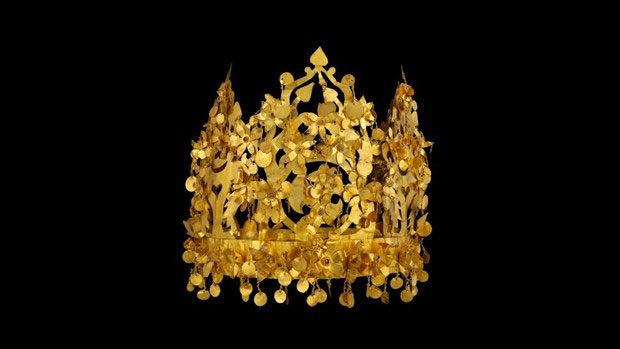Some sources indicate that the Taliban is on the hunt for Afghanistan’s most famous treasure – the “Bactrian Treasure”. This collection consists of over 20,000 artifacts, many of which are made of gold.
With the Taliban’s takeover of Afghanistan, the country’s archaeological sites face a grim future, even if the group decides not to loot or intentionally destroy them.
Some sources suggest that the Taliban is seeking one of Afghanistan’s most renowned treasures. This treasure, known as the “Bactrian Treasure”, includes a collection of over 20,000 artifacts, many of which are made of gold.

Golden Crown – one of the gold artifacts in the Bactrian Treasure of Afghanistan. (Source: Getty)
The Bactrian Treasure was discovered in a 2,000-year-old tomb at Tillya Tepe in 1978. The treasure was once housed in the National Museum of Afghanistan and later displayed in the presidential palace. However, the exact location of this treasure is still unknown.
Other archaeological sites that may be threatened by the Taliban include Mes Aynak, a flourishing Buddhist city that existed approximately 1,600 years ago. This city lies along the Silk Road and was known for its rich commercial and spiritual activities.
During their rule in Afghanistan from 1996 to 2001, the Taliban destroyed many Buddhist artifacts, including two colossal statues carved into a cliff from the 6th century, known as the “Buddhas of Bamiyan”.
The group used missiles, tank artillery, and explosives to obliterate these towering statues.
The future of Mes Aynak appears particularly bleak, as all equipment used for excavation and preservation in the area is no longer available.
So far, there have been no reports of the Taliban intentionally destroying artifacts. The Taliban leadership has stated they will protect archaeological sites; however, it remains uncertain whether they will truly keep this promise.
Alongside his team, Gil Stein – a professor at the Oriental Institute of the University of Chicago and the leader of the Afghanistan Heritage Mapping Partnership – has utilized satellite imagery to map and monitor thousands of archaeological sites in Afghanistan.
Stein estimates they have identified the locations of approximately 25,000 archaeological sites in Afghanistan to date.
Artifact theft is an issue in Afghanistan, but Stein has not found any evidence that the Taliban has supported such activities.
He believes that only time will reveal whether the Taliban will genuinely refrain from looting or destroying archaeological sites. He noted one encouraging point: the Taliban has stationed guards outside the National Museum of Afghanistan.
Interestingly, over the past two decades, some artifacts stolen or taken from Afghanistan have been found in the United States. The U.S. has since returned them to Afghanistan, and these artifacts are currently housed in the National Museum of Afghanistan.





















































